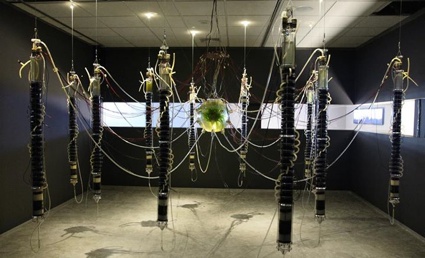 Gilberto Esparza, Plantas Autofotosintéticas, 2013-2014
Gilberto Esparza, Plantas Autofotosintéticas, 2013-2014
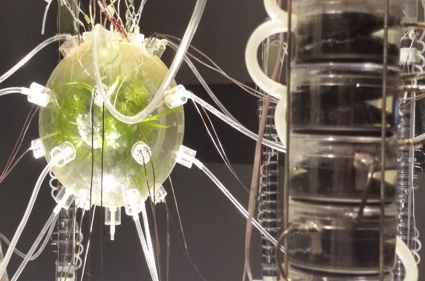 Gilberto Esparza, Plantas Autofotosintéticas, 2013-2014. Photo: Fundación Telefonica
Gilberto Esparza, Plantas Autofotosintéticas, 2013-2014. Photo: Fundación Telefonica
For a number of years, artist Gilberto Esparza has been using recycled electronics, alternative forms of energy and other modern technologies to investigate the action of human beings on the environment. His Urban Parasites are small robotic insects made of recycled consumer goods. They climb, crawl and hang over the urban space in search of any source of energy they can feed on. In 2010, he developed Nomadic Plants, a robot hosting living plants and microorganisms. Whenever its ‘guests’ need to be fed, the autonomous robot will move towards a contaminated river and drink water from it. Through a process of microbial fuel cells, the elements contained in the water are transformed into energy that powers its circuits. The cleaned up water is then sprayed onto the plants.
Like Nomadic Plants, but on a larger scale, Esparza‘s new research project makes use of microbial fuel cells technology to produce electricity and improve the quality of water.
Autophotosynthetic Plants takes the form a hybrid, self-regulating organism. Part machine, part organic ecosystem, it feeds on organisms found into the sewage water of Lima, Peru, in order to create its own light, energy and be self-sufficient.
As any living organism, Autophotosynthetic Plants features a central system where microorganisms, crustaceans and algae live; a digestive system where bacteria feed on polluted water and transform it into cleaner water that can be used for photosynthesis; and a nervous system made of an electronic network that monitors the activities of the organic parts.
The process is probably better explained in the video below:
The modules create hydraulic network that administers bio-filtered water to the central container, creating an optimal environment where producer species and consumer species from different trophic levels (protzoans, crustaceans, micro algae and aquatic plants) can achieve homeostatic equilibrium. The electricity produced by the bacteria is released as intervals of luminous energy, enabling photosynthesis by the plants that inhabit the central container which thereby complete their metabolic processes. When the organic material present in the microbial cells has been entirely consumed, an electronic monitoring networks pumps out the byproducts generated by the species that inhabit the nuclear ecosystem to the modular cells, restoring the cycle.
The ambitious project not only suggests that polluted water can be used as a source of energy but it also stands as a model that could potentially be applied to other cities, communities and industries.
I contacted the artist to know more about the project (Scroll down if you prefer to read the interview in Spanish):
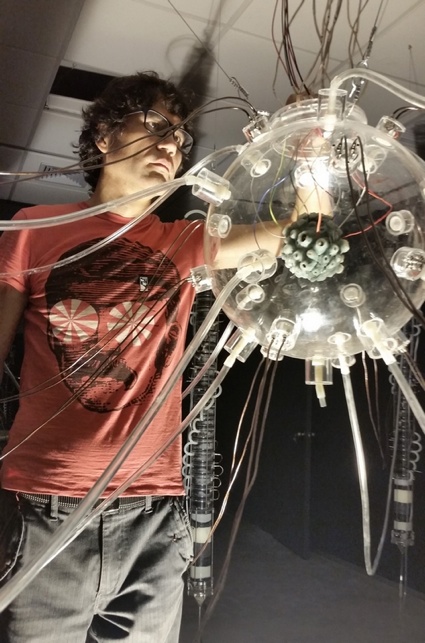 Gilberto Esparza, Plantas Autofotosintéticas, 2013-2014. Photo: Fundación Telefonica
Gilberto Esparza, Plantas Autofotosintéticas, 2013-2014. Photo: Fundación Telefonica
Hi Gilberto! Where do the electricity-bacteria come from? Did you find them existing already in the contaminated water? Or were there introduced from another source? Are they the same bacterias as in Plantas nomadas?
The bacteria come from the rivers where the samples are taken. One of the bacteria commonly found in organic waste is the Geobacter which has been used in various studies to generate energy by microbial fuel cells. It is the same system that Nomadic Plants is using.
The obvious question is: could the system be implemented on a large scale? Going thus from the scale of an art installation in an exhibition room to a fully functional system used for a whole area of the city?
Yes, all the research centers that are working with this technology have that possibility in mind. The idea is to implement the use of microbial cells in wastewater treatment plants to reduce the power consumption that the plant requires.
Does the system require a lot of maintenance and attention? Or does it pretty much manage itself without any help from you or from scientists?
The installation has analog electronics and multiple sensors that auto-regulate the functioning of the installation. The only maintenance consists in aliment it with wastewater each time a biodegradation cycle ends.
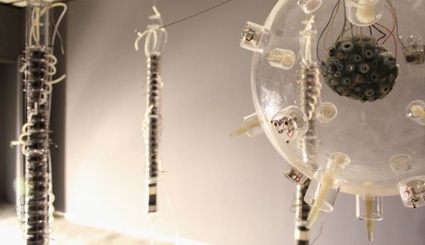 Gilberto Esparza, Plantas Autofotosintéticas, 2013-2014. Photo: Christian Sánchez
Gilberto Esparza, Plantas Autofotosintéticas, 2013-2014. Photo: Christian Sánchez
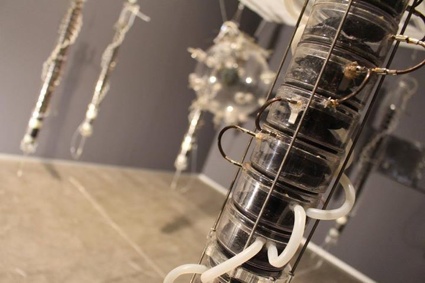 Gilberto Esparza, Plantas Autofotosintéticas, 2013-2014. Photo: Christian Sánchez
Gilberto Esparza, Plantas Autofotosintéticas, 2013-2014. Photo: Christian Sánchez
In the video, you explain that you took water from various parts of the city and that each zone of the city had its own level and type of pollution. Could you explain a bit more? How does that translate in the installation? Do the various types of polluted water require different bacteria? produce different intensity or types of energy?
It depends on the area where the samples were taken. In industrial areas, for example, you can find a higher amount of toxic waste that sometimes inhibit bacteria. In other sectors of the city, household waste generate more organic matter. In those waters bacteria feed on this waste and produce more energy and this energy is reflected in the installation in the form in flashes of light that are more intense and that make aquatic plants perform their photosynthetic processes better.
In the video, we see visitors entering the room of Plantas autofotosintéticas wearing a mask. Is it because the installation has a bad smell? Or is dangerous to breathe in? https://www.youtube.com/watch?v=4wyL4jRlqbY
The installation emits bad smells and presents a source of infection for visitors, so we decided to protect them. I find this approach to the work interesting because those same conditions are found in the urban area bordering polluted rivers and their inhabitants are exposed to them all the time.
Thanks Gilberto!
And now for the spanish version of the interview:
¿De dónde provienen las bacterias que se alimentan de electricidad? Ya existían en el agua contaminada? O lo habías introducido desde otra parte? ¿Son las mismas bacterias en Plantas nómadas?
Las bacterias provienen de los ríos de donde sacan las muestras, una de las bacterias que es muy común en donde se presentan desechos orgánicos es la Geobacter con las que se han estado haciendo diversos estudios para la generación de energía a través de celdas de combustible microbianas. Es el mismo sistema que utiliza Plantas Nómadas.
¿Se podría llevar a gran escala el sistema? Yendo solo así de la escala de una instalación de arte en una sala de exposiciones a un sistema totalmente funcional utilizada para toda una zona de la ciudad?
Sí, todos los centros de investigación que están trabajando con esta tecnología tienen presente esa posibilidad. La idea es implementar el uso de las celdas microbianas en las plantas de tratamiento de aguas residuales para disminuir el consumo de energía que la planta requiere.
¿El sistema requiere mucha atención, mantenimiento? ¿O más o menos se maneja por sí mismo sin ninguna ayuda de usted o de los científicos?
La instalación tiene una electrónica análoga y múltiples censores que autorregulan el funcionamiento de la instalación, el único mantenimiento es proveerle de aguas residuales cada que termine el ciclo de biodegradación.
En el vídeo, se explica que le “tomó agua de diversas partes de la ciudad y que cada zona de la ciudad tiene su propio nivel y tipo de contaminación. ¿Podría explicar un poco más? ¿Cómo se traduce en la instalación? ¿Los distintos tipos de aguas contaminadas requieren diferentes bacterias? produce diferentes tipos de energía o la intensidad?
Depende de la zona en donde se tomaron las muestras, se presentas distintos contaminantes por ejemplo en las zonas industriales se presentan mas desechos tóxicos que algunas veces inhiben a las bacterias. En otros sectores de la cuidad, se presentan más materia orgánica por desechos domésticos, en esas aguas las bacterias se alimentas de estos desechos y producen más energía y esta energía se manifiesta en la instalación como destellos de luz más intensos que hacen que las plantas acuáticas que habitan en el núcleo realicen mejor sus procesos fotosintéticos.
En el video, vemos a los visitantes que entran en la habitación de las Plantas autofotosintéticas con una máscara. ¿Es porque la instalación tiene un mal olor? ¿O es peligroso para respirar?
La instalación despide malos olores y representa un foco de infección para los espectadores, por eso se decidió protegerlos. Esta aproximación a la obra me interesa porque esas mismas condiciones se encuentran en las zona urbanas que colindan con los ríos contaminados y que sus habitantes están expuestos todo el tiempo.
¡Muchas gracias Gilberto!
